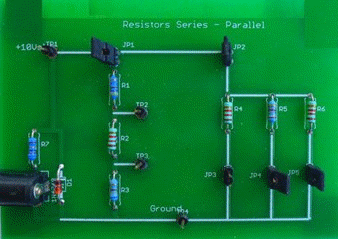 Resistors in series–parallel combination
To find the total resistance of the above circuit the parallel combination has to be evaluated first and then the series combination.
Resistors in series–parallel combination
To find the total resistance of the above circuit the parallel combination has to be evaluated first and then the series combination.
Resistors in a circuit may be connected together in two ways: (1) Series (2) Parallel.
(1) SERIES combination: In this combination, the same current flows through all the components but a different potential difference (voltage) can exist across each one.
(2) PARALLEL combination: In this combination, the same potential difference (voltage) exists across all the components but each component may carry a different current.
In either case (for resistors) the total resistance of that part of the circuit containing the resistors can be calculated using the methods described below.
For resistors in series:
The total resistance of two (or) more resistors connected in series is given by simply adding the individual values of the resistors to find the total sum we have.,
(RTOT) = R1+R2+R3....
For resistors in parallel:
The total resistance of two (or) more resistors connected in parallel is given by.,
RTOT = R1R2 / (R1+R2)
If there are more than two parallel resistors, just choose two of them and work out the total resistance for these two–then use that total as if it was a single resistor and make another pair with a third resistor.
The combined value of any number of parallel resistors will always be LESS than the value of the smallest individual resistor in the network.